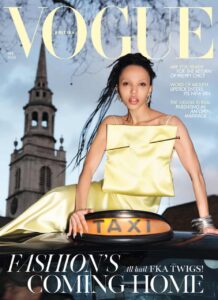
A wardrobe overspilling with secondhand clothing and a pair of fuzzy donkeys are just some of the more unexpected stars of Chioma Nnadi’s debut British Vogue issue.
While historically Vogue’s September issues are the biggest, attracting new season advertising from luxury brands, Nnadi’s highly anticipated debut has resulted in the highest ever print revenue for an April issue. It will land with a hefty thud on subscribers’ doormats on Saturday while non-subscribers can lug it off shelves from Tuesday.
Last month her predecessor, Edward Enninful, put 40 celebrities including Oprah Winfrey and Naomi Campbell on his final cover, leaving Nnadi with a somewhat monumental legacy to navigate. For her first cover, trying to outdo that would be impossible. So it seems British Vogue’s new head of editorial content has decided to set out her own barometer of cool with a single star.
Her cover features the British musician FKA twigs sitting atop a London black cab. In place of a slick studio she is shot outdoors, in Hackney, glaring rather than grinning at the camera. She wears a lemon-coloured silk dress from Loewe (a coup for the Spanish brand led by the Northern Irish designer Jonathan Anderson) that features a giant silver pin pierced through its front. Her eyebrows are bleached. Her nails are talon-like. It’s more effortless than tightly constructed. “Fashion’s coming home” states the cover line – a nod to London-born Nnadi’s own recent return to “home turf” to take up the role after two decades in New York.
“FKA twigs is an artist who represents the ideal of the modern British eccentric,” writes Nnadi in a cover letter. “She is a shape-shifter who rejects conformity and takes real joy in clothes.”
The joy of clothes is a recurring theme throughout the issue. Nnadi muses on spending hours as a teenager observing students outside Central Saint Martins. “This wasn’t about designer label-spotting – most of the kids didn’t, of course, have enough money to shop on Bond Street – but about noting how they would put together the eclectic pieces they’d found at car boot.”
It’s this ethos that still thrills her. She sets out her fashion values from the get-go with the first six opening pages featuring interviews with vintage collectors. A special shopping section entitled “got to be real” mixes £8,000 bags from Chanel with an £8.50 T-shirt from M&S. A secondhand pair of Simone Rocha cherry red crystal earrings sourced from eBay are given the same still life photography reverence as a fresh-off-the catwalk £3,100 Louis Vuitton bag.
While this high/low shopping approach is commonly championed by gen Z, it’s rare to see such a prevalence of it in a glossy magazine. It’s even more unusual for the average reader to be able to afford multiple pieces from Vogue.
The rest of the content is eclectic, but with more than two decades of experience as a journalist, Nnadi’s curation is carefully considered. There’s an essay on juggling an open marriage with parenting, a deep dive into the effects of neuroscience on skin health and a roundup of new nonfiction from female writers.
